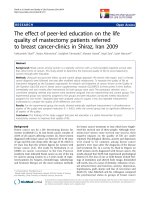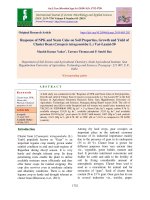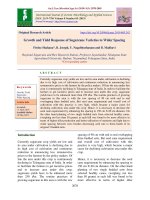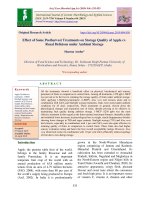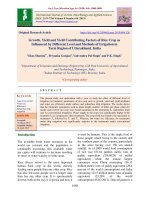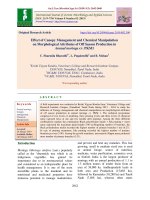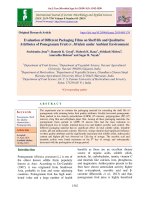Response of pre and post-harvest chemical applications on storage life, quality and cost economics of Mango cv. Dashehari in Tarai region of Uttarakhand, India
Bạn đang xem bản rút gọn của tài liệu. Xem và tải ngay bản đầy đủ của tài liệu tại đây (353.79 KB, 6 trang )
Int.J.Curr.Microbiol.App.Sci (2018) 7(11): 2755-2760
International Journal of Current Microbiology and Applied Sciences
ISSN: 2319-7706 Volume 7 Number 11 (2018)
Journal homepage:
Original Research Article
/>
Response of Pre and Post-Harvest Chemical Applications on
Storage Life, Quality and Cost Economics of Mango cv. Dashehari
in Tarai Region of Uttarakhand, India
Pant*, Pooja and C.P. Singh
Department of Horticulture, G.B. Pant University of Agriculture & Technology, Pantnagar,
US Nagar, Uttarakhand – 263145, India
*Corresponding author
ABSTRACT
Keywords
Mango, CaCl2, GA3,
Dashehari, Quality
Article Info
Accepted:
22 October 2018
Available Online:
10 November 2018
The present investigation was undertaken on mango cv. Dashehari with the objective to
find out suitable treatments for better storage life, quality and net profit of mango fruits.
The experiment was laid out in factorial completely randomized design comprising of 8
pre and 10 post-harvest treatments. The pre harvest application of GA3 @ 15 ppm + CaCl2
@ 2.0% and post-harvest dipping with GA3 @ 400 ppm + CaCl2 @ 6.0% and hot water +
CaCl2 @ 6.0% resulted in minimum physiological loss in weight (10.30 % and 10.67%,
respectively) and maximum shelf life (13.25 days), total sugars (18.76% and 17.76%,
respectively), ascorbic acid (45.78 mg100g-1 and 46.47mg100g-1, respectively) and β –
carotene (1.983 mg100g-1 and 1.971 mg100g-1, respectively).
Introduction
Mango is well established for international
trade due to its superb quality. The export
market for mango has become highly
lucrative. Domestic and international trade of
fresh mango has been limited by its highly
perishable nature and susceptibility to postharvest diseases and physical injuries. Postharvest losses have been estimated in
developed countries from 5-25%, while in
developing countries it is near to 20-50%
(Cisneros-Zevallos, 2003). The losses after
harvesting of fruits are more due to
mismanagement of produce and unfavourable
physiological, biological and environmental
factors.
Therefore, it is essential to overcome the
problems associated with the produce by
proper handling and care after harvesting of
fruits. Many attempts have been made to
increase the shelf life and maintain the postharvest health of fruit which includes hot
water treatment, irradiation, use of fungicides,
growth regulators, nutrients, packaging and
storage at low temperature.
Materials and Methods
The present investigation was conducted at
Horticulture Research Centre, Patherchatta,
G.B.P.U.A.T, Pantnagar, Uttarakhand, India
(29.5o N latitude and 79.3o E longitude)
during two successive seasons of 2012 and
2755
Int.J.Curr.Microbiol.App.Sci (2018) 7(11): 2755-2760
2013 on mango cv. Dashehari. The climate of
the area is humid subtropical with dry hot
summers (320C -450C) and cool winters (00C90C). Frost can be expected from last week of
December to middle of February. Rainy
season is usually from 2nd week of June to
2nd week of September with heavy rainfall
(1400 mm). The experiment was laid out in
CRD factorial comprising of 8 pre and 10
post-harvest treatments (mentioned in tables)
and each treatment replicated thrice. The preharvest foliar spray of chemicals on 25 years
old trees of mango cv. Dashehari was done 20
days before harvesting of fruits, while, the
post-harvest treatment in form of dipping in
different chemicals dipping was done after
harvesting and kept in ventilated CFB boxes
and stored at ambient temperature (30-360C)
for further studies. Fruit setting was started in
Februrary- March. And fully matured fruits
were picked in last week of June. During
maturation phase (from 18 to 25 standard
week) maximum temperature varied from 38.3
to 34.10C and 36.1 to 41.10C, minimum 22.0 –
25.60C and 18.6 to 27.80C, relative humidity
varied from 63-82% (morning) to 31-61%
(evening) and 47-66% (morning) to 18-41%
(evening), sunshine hours from 6.6 to 9.5 hrs
and 3.3 to 10.6 hrs during 1st and 2nd season,
respectively. The total rainfall during this
period was 156.6mm and 21.2 mm.
Treatment wise, the mango fruits of both the
experiments were stored in a clean, hygienic
and well ventilated room at ambient condition
(temperature 31±1 °C and humidity 60± 5%).
Observations on storage life (D), total sugars
(%), ascorbic acid (mg100g-1) and β –
carotene (mg100g-1) were recorded. The total
sugars, ascorbic acid and β – carotene was
determined as per AOAC (1990), while,
economics was calculated on the basis of
market rate prevailed at that period. The data
was statistically analysed to know the
significance among the mean values of the
treatments.
Results and Discussion
The data on storage life and total sugars are
summarized in Table 1. The pre harvest spray
and post-harvest dipping of chemicals
enhanced storage life of fruits under all the
treatments over control. The storage life of
fruits treated with chemicals could be
extended up to 13 days over 7 days of
untreated ones (control). The longest storage
life (13.25 days) was observed with the pre
harvest application of GA3 @ 15 ppm +
CaCl24@ 2.0% and post-harvest dipping with
GA3 @ 400 ppm + CaCl2 @ 6.0% (T3) and hot
water + CaCl2 @ 6.0% (T9).
The increase in storage life might be due to
less weight loss, spoilage, shrivelling and
enhanced fruit firmness, which provide
improved fruit colour, better appearance,
glossiness and enhanced market acceptability
(Choudhury et al., 2003).
During the storage durations, the total sugar
contents of the fruits increased gradually with
advancement of storage period and reached to
the maximum levels (18.76% and 17.76%,
respectively) on 9th day of storage with the pre
harvest spray of GA3 @ 15 ppm + CaCl2 @
2.0% (T3) (0.291%) and post-harvest dipping
with hot water + CaCl2 @ 6.0% (T9) (0.310%).
The increase in total sugar may be due to
breakdown of complex polymers in to simple
substances by hydrolytic enzymes (Mahajan et
al., 2004; Wahdan et al., 2011).
The data on ascorbic acid (mg100g-1) and β –
carotene (mg/100g) are summarized in Table
2. The pre harvest spray of GA3 @ 15 ppm +
CaCl2@ 2.0% (T3) and post-harvest dipping
with GA3 @ 400 ppm + CaCl2 @ 6.0% (T3)
registered a very low and gradual decline in
ascorbic acid content with advancement of
storage period and was recorded 45.78
mg100g-1 and 46.47mg100g-1, respectively on
the day of harvest.
2756
Int.J.Curr.Microbiol.App.Sci (2018) 7(11): 2755-2760
Table.1 Effect of pre and post-harvest treatments on storage life and total sugar percent of mango cv.
Dashehari during storage (Pooled analysis)
Treatments (T)
Storage
Life(D)
0
T1:CaCl2@ 2%
T2 :GA3 @ 15ppm
T3 :GA3 @ 15 ppm + CaCl2@ 2.0%
T4 :Bavistin @ 0.5%
T5 :Bavistin @ 0.5% + CaCl2 @ 2.0%
T6 :Indoneem @ 500 ppm
T7 :Indoneem @ 500 ppm + CaCl2@ 2.0%
T8 :Control
Mean
CD at 5% (T x D)
12.00
11.17
13.25
9.00
10.08
8.00
8.00
7.00
0.728
T1 :CaCl2@ 6%
T2 :GA3 @ 400ppm
T3 :GA3 @ 400 ppm + CaCl2@ 6.0%
T4 :Bavistin @ 0.1%
T5 :Bavistin @ 0.1% + CaCl2 @ 6.0%
T6 :Indoneem @ 500 ppm
T7 :Indoneem @ 500 ppm + CaCl2@ 6.0%
T8 :hot water
T9 :hot water + CaCl2 @ 6.0%
T10 :Control
Mean
CD at 5% (T x D)
12.17
11.17
13.25
11.17
12.00
8.50
9.58
13.00
13.25
7.00
0.678
2757
9.02
9.10
9.51
9.20
9.65
9.37
9.53
8.78
9.27
9.37
9.38
9.58
9.67
9.57
9.53
9.66
9.40
9.38
9.22
9.47
3
10.93
11.13
12.77
11.69
13.02
12.19
12.69
13.88
12.29
11.51
11.65
11.33
11.39
11.35
11.91
11.84
11.17
11.04
13.34
11.65
Total Sugars (%)
Storage intervals in days (D)
6
9
12
14
Preharvest
14.56
16.90
16.47
15.81
14.78
17.12
16.66
16.04
15.95
18.76
18.33
17.75
14.59
16.74
16.30
15.64
15.75
17.81
17.38
16.75
14.94
17.07
16.61
15.96
15.69
17.68
16.72
16.05
17.22
14.99
13.61
12.50
15.44
17.13
16.51
15.81
0.185
Post-harvest
13.91
16.71
16.08
15.12
14.33
16.45
15.84
14.83
13.54
17.35
16.85
16.00
13.69
16.99
16.43
15.56
13.80
17.10
16.52
15.69
15.29
15.92
15.21
14.03
15.03
16.05
15.38
14.27
13.33
17.58
17.08
16.27
13.13
17.76
17.31
16.44
16.40
14.96
14.24
13.07
14.24
16.69
16.09
15.13
0.087
Mean
13.95
14.14
15.51
14.03
15.06
14.36
14.73
13.50
14.41
13.78
13.74
14.11
13.95
14.00
13.65
13.70
14.14
14.18
13.54
13.88
Int.J.Curr.Microbiol.App.Sci (2018) 7(11): 2755-2760
Table.2 Effect of pre and post-harvest treatments on the Ascorbic acid and β-Carotene of mango cv.
Dashehari during storage (Pooled analysis)
Ascorbic acid (mg100g-1)
Treatments (T)
β-Carotene (mg100g-1)
Storage intervals in days (D)
0
3
6
9
12
Storage intervals in days (D)
14
Mean
0
3
6
9
12
14
Mean
0.875
1.562
1.947
1.928
1.904
1.418
T1:CaCl2@ 2%
43.85
38.64
31.47
27.09
22.81
20.31
Pre harvest
30.69 0.294
T2 :GA3 @ 15ppm
43.99
38.84
31.75
27.36
23.67
21.02
31.10
0.298
0.885
1.583
1.957
1.936
1.909
1.428
T3 :GA3 @ 15 ppm + CaCl2@ 2.0%
45.78
40.55
35.00
30.47
26.05
23.51
33.56
0.293
0.918
1.641
1.983
1.967
1.948
1.458
T4 :Bavistin @ 0.5%
44.20
37.53
32.01
27.72
23.80
21.03
31.05
0.287
0.880
1.566
1.952
1.938
1.916
1.423
T5 :Bavistin @ 0.5% + CaCl2 @ 2.0%
45.15
39.90
33.33
30.15
25.67
22.14
32.72
0.289
0.913
1.629
1.974
1.955
1.926
1.447
T6 :Indoneem @ 500 ppm
43.09
37.29
30.23
26.17
21.32
19.00
29.52
0.288
0.868
1.531
1.935
1.914
1.891
1.404
T7 :Indoneem @ 500 ppm + CaCl2@ 2.0%
43.62
38.09
30.99
26.73
23.31
20.52
30.54
0.283
0.907
1.546
1.943
1.923
1.901
1.417
T8 :Control
43.54
34.78
29.18
24.51
19.66
17.87
28.26
0.281
1.147
1.815
1.789
1.760
1.727
1.420
Mean
44.15
38.20
31.75
27.52
23.29
20.68
30.93
0.289
0.924
1.609
1.935
1.915
1.890
1.427
0.559
CD at 5% (T x D)
0.004
T1 :CaCl2@ 6%
44.52
39.25
34.77
25.88
22.05
19.46
Post-harvest
30.99 0.252
0.874
1.401
1.910
1.891
1.872
1.366
T2 :GA3 @ 400ppm
45.76
41.22
36.32
27.62
22.09
21.32
32.39
0.260
0.852
1.378
1.958
1.942
1.926
1.386
T3 :GA3 @ 400 ppm + CaCl2@ 6.0%
46.47
41.90
36.50
28.02
23.71
21.60
33.03
0.260
0.846
1.370
1.971
1.956
1.941
1.391
T4 :Bavistin @ 0.1%
44.86
39.52
34.55
26.04
22.14
19.92
31.17
0.257
0.868
1.390
1.928
1.907
1.893
1.374
T5 :Bavistin @ 0.1% + CaCl2 @ 6.0%
45.26
39.94
35.17
26.53
22.28
20.20
31.56
0.255
0.863
1.368
1.943
1.925
1.908
1.377
T6 :Indoneem @ 500 ppm
44.10
38.44
33.44
24.78
21.20
18.71
30.11
0.252
0.886
1.420
1.890
1.870
1.849
1.361
T7 :Indoneem @ 500 ppm + CaCl2@ 6.0%
44.63
39.16
34.08
25.28
21.26
19.42
30.64
0.253
0.879
1.413
1.898
1.877
1.858
1.363
T8 :hot water
44.04
38.39
33.25
23.16
20.48
19.02
29.72
0.251
0.908
1.440
1.862
1.840
1.818
1.353
T9 :hot water + CaCl2 @ 6.0%
43.96
38.29
33.63
24.68
20.61
18.51
29.94
0.251
0.899
1.430
1.878
1.857
1.836
1.358
T10 :Control
44.20
36.33
30.36
23.90
20.46
17.82
28.85
0.254
1.132
1.764
1.740
1.716
1.692
1.383
Mean
44.78
39.24
34.21
25.59
21.63
19.60
30.84
0.254
0.901
1.437
1.898
1.878
1.859
1.371
CD at 5% (T x D)
0.363
0.010
2758
Int.J.Curr.Microbiol.App.Sci (2018) 7(11): 2755-2760
Table.3 Cost economics of different pre and post-harvest treatments on mango fruits cv. Dashehari (Pooled)
Treatments (T)
Fruit
spoilage
on 12th
day (per
cent)
Good
quality
mango
(per
cent)
Sale rate
of 100
mangos
(Rs.)
Sale price
of good
quality
fruits (Rs.)
T1:CaCl2@ 2%
T2 :GA3 @ 15ppm
T3 :GA3 @ 15 ppm + CaCl2@ 2.0%
T4 :Bavistin @ 0.5%
T5 :Bavistin @ 0.5% + CaCl2 @ 2.0%
T6 :Indoneem @ 500 ppm
T7 :Indoneem @ 500 ppm + CaCl2@ 2.0%
T8 :Control
30.52
27.85
25.44
18.29
19.14
33.43
34.11
41.69
69.48
72.85
74.56
81.29
80.86
66.57
65.89
58.31
600
550
550
600
600
500
500
400
416.88
400.67
410.08
487.74
485.16
332.85
329.45
233.24
T1 :CaCl2@ 6%
T2 :GA3 @ 400ppm
T3 :GA3 @ 400 ppm + CaCl2@ 6.0%
T4 :Bavistin @ 0.1%
T5 :Bavistin @ 0.1% + CaCl2 @ 6.0%
T6 :Indoneem @ 500 ppm
T7 :Indoneem @ 500 ppm + CaCl2@ 6.0%
T8 :hot water
T9 :hot water + CaCl2 @ 6.0%
T10 :Control
30.12
29.86
28.50
18.33
18.93
30.78
32.01
17.09
14.80
50.25
69.88
70.14
71.50
81.67
81.07
69.22
67.99
82.91
85.20
49.75
600
600
600
650
650
500
500
700
700
400
419.28
420.84
429.00
530.85
526.95
346.10
339.95
580.37
596.40
199.00
2759
Total cost of
treatments
(Rs.)
Pre harvest
36.49
35.29
38.45
33.48
36.64
43.33
49.94
0.00
Post-harvest
42.81
85.73
95.21
33.36
42.84
43.33
52.81
33.33
42.81
0.00
Net
Profit
(Rs.)
Profit
over
control
(Rs.)
380.39
365.38
371.63
454.26
448.52
289.52
279.51
233.24
147.15
132.14
138.39
221.02
215.28
56.28
46.27
0.00
376.47
335.11
333.79
497.49
484.11
302.77
287.14
547.04
553.59
199.00
177.47
136.11
134.79
298.49
285.11
103.77
88.14
348.04
354.59
0.00
Int.J.Curr.Microbiol.App.Sci (2018) 7(11): 2755-2760
The decrease in ascorbic acid is due to oxidative
destruction of ascorbic acid in the presence of
molecular oxygen by ascorbic acid oxidase
enzyme (Kirmani et al., 2013).
β-carotene content of the fruits treated with
chemicals increased up to 9th day and after
attaining the respective peaks, it declined with
advancement of storage period till 14th day of
storage. The maximum β-carotene content was
obtained by pre harvest spray of Gibberellic
acid @ 15 ppm + Calcium chloride @ 2.0%
(T3) (1.983 mg100g-1) and post-harvest dipping
with GA3 @ 400 ppm + CaCl2 @ 6.0% (T3)
(1.971 mg100g-1) on 9th day of storage. The
decline in β-carotene might be due to their
utilization in evapo-transpiration and other
biochemical activities (Bhatt et al., 2012; Yadav
et al., 2010).
Estimation of profit for 100 fruits over control
(Table 3) indicated that maximum net profit
(Rs.221.02 and Rs.354.59, respectively) was
obtained from fruits of pre-harvest treatment
Bavistin @ 0.5% (T4) and post-harvest
treatment Hot water dipping + Calcium chloride
@ 6.0% (T9). Net profit of control fruits was
taken as Rs. 0.00 for comparison with all treated
fruits.
Thus, it may be concluded that the pre harvest
spray with Gibberellic acid @ 15 ppm +
Calcium chloride @ 2.0% and post-harvest
dipping with GA3 @ 400 ppm + CaCl2 @ 6.0%
and Hot water + Calcium chloride @ 6.0% are
the most effective treatments for increased net
profit, storage life as well as maintained fruit
quality of mango cv. Dashehari.
References
A.O.A.C. 1990. Official Methods of Analysis.
Association
of
Official
Analytical
Chemists, Washington, D.C.
Bhatt, A., N.K Mishra, D.S. Mishra and C.P.
Singh 2012. Foliar application of
potassium, calcium, zinc and boron
enhanced yield, quality and shelf life of
mango. Hort-Flora Research Spectrum,
1(4): 300-305.
Choudhury, S., D.P. Ray, B.K. Das and G.S.
Sahu, 2003. Effect of pre and post-harvest
chemical treatments on ripening, quality
and storage life of sapota (Manilkara
achras (Mill.) Forberg) cv. Pala. Orissa
Journal of Horticulture, 31(2): 54-57.
Cisneros-Zevallos, L. 2003. The use of controlled
postharvest abiotic stresses as a tool for
enhancing the nutraceutical content and
adding-value of fresh fruits and vegetables.
Journal of Food Science, 68: 1560-1565.
Kirmani, S.N., G.M. Wani, M.S. Wani, M.Y.
Ghani, M. Abid, S. Muzamil, H. Raja and
A.R. Malik, 2013. Effect of preharvest
application of Calcium chloride (CaCl2),
Gibberellic acid (GA3) and Napthelenic
acetic acid (NAA) on storage of Plum
(Prunus salicina L.) cv. Santa Rosa under
ambient storage conditions. African Journal
of Agricultural Research, 8(9): 812-818.
Mahajan, B.V.C., A.S. Dhatt, and W.S. Dhilon,
2004. Effect of pre-storage treatments on
quality and storage life of Asian pear.
Indian Journal of Horticulture, 61(4): 342344.
Wahdan, M.T., S.E. Habib, M.A. Bassal, and
E.M. Qaoud, 2011. Effect of Calcium
chloride and Gibberellic acid on storability
of “Succary Abiad” mango fruits under
cold storage. Journal of American Science,
7(5): 493-501.
Yadav, M., N. Kumar, D.B. Singh, and G.K.
Singh, 2010. Effect of post-harvest
treatments on shelf life and quality of
Kinnow mandarin. Indian Journal of
Horticulture, 67(2): 243-248.
How to cite this article:
Pant, Pooja and Singh, C.P. 2018. Response of Pre and Post-Harvest Chemical Applications on Storage
Life, Quality and Cost Economics of Mango cv. Dashehari in Tarai Region of Uttarakhand, India.
Int.J.Curr.Microbiol.App.Sci. 7(11): 2755-2760. doi: />
2760
